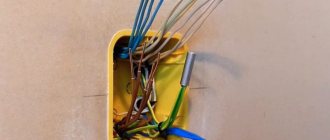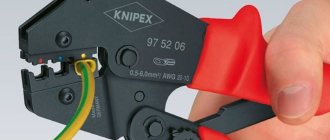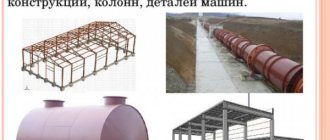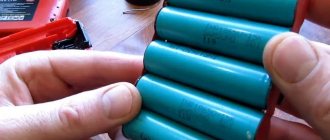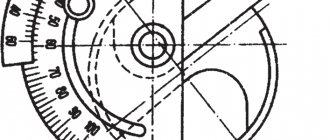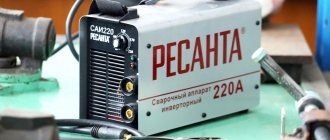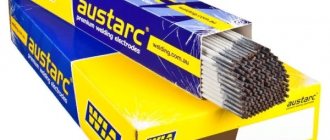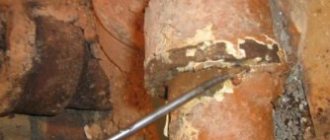The market for the production and sale of welding equipment offers a wide range of equipment of rectifier, transformer and inverter types. It is the latter type that is most widespread.
Inverters are easy to use, compact, mobile, easy to connect, affordable, and suitable for beginners and experienced professionals. The popularity of this equipment requires the correct choice of cable for it. The article will discuss which cable is best to use for an inverter welding machine.
Welding cable design
To ensure the normal functioning of the inverter, wires with a copper base should be used.
Copper is the best conductor of electric current. You should also use cords that are highly flexible. They simplify the work process and guarantee freedom of action for the performer. The cable design includes the following elements :
- conductive copper core consists of many wires, the cross-section of which does not exceed 0.2 mm;
- covering can be made of rubber or rubber (natural or butadiene);
- The separating layer is made of a special transparent film that prevents the coating and core from sticking together.
Suitable cable brands and types
The most popular option for a welding machine is the KG cable; it is a flexible single-core cable with a stranded core in rubber insulation. COG is also popular - with increased flexibility. There is also a specialized KS, these are the main brands of conductors that are used for welding work.
The title may also contain a note about the performance:
- T – tropical version, can operate at ambient temperatures up to +50 (according to some sources 85) degrees Celsius.
- KX or HL - frost-resistant, works even at -60 degrees Celsius.
And also the prefix P - an additional sheath of the core made of polymer materials.
The numbers in the marking indicate the number of cores and their cross-section, for example: KG 1x16 indicates that it consists of 1 core with a cross-sectional area of 16 square meters. mm.
Characteristics of welding cables
As noted earlier, the cable for the inverter must be highly flexible . In addition to this important property, electrical conductors are required to meet the following characteristics :
- Strength , i.e. resistance to mechanical stress: shocks and tears.
- Resistance to temperature fluctuations, the ability to use the conductor in conditions of very low or fairly high temperatures.
- Resistant to sunlight and moisture .
- Immunity to mold and mildew .
- Elasticity – minimal likelihood of bending.
[ads-pc-3][ads-mob-3]
Cable requirements for a welder
Firstly, if you choose a cable to connect the ground clamp and electrode holder to the welding machine, you need to consider the following operating features:
- Welding machines of any type produce significant currents - from 10-20 to 400-500A. At the same time, household inverter-type welding machines are usually designed for 200A with a deviation of 50A in each direction, and industrial welding transformers produce currents of 400A.
- A welder encounters a wide variety of tasks in his work, from simple seams in convenient positions to welding products of complex shapes or in hard-to-reach places.
- In addition to various tasks, you have to cook both in very hot rooms and in the cold in winter.
- To transport the equipment, the cables are rolled up.
It follows that the cable must meet the following requirements:
- The power welding cable must be flexible to ensure ease of manipulation of the electrode or torch for a semi-automatic welding machine.
- The conductor must have thick insulation and be resistant to aggressive environments, shocks and breaks.
- To work in cold conditions, the conductor must be frost-resistant.
- Welding of metals occurs with low voltage but high current, so there is a separate requirement for the cross-section of wires for connecting electrode holders and ground. This means that the wire must be thick to minimize voltage sags and losses.
- Must withstand repeated bending and winding/unwinding during transportation.
Welding cable for inverter: types
There are few brands of conductors designed specifically for welding work. And there are only two types of cables that meet the above characteristics: KG and KOG.
Among craftsmen, the first type is in particular demand - flexible cable (KG). It should be used to connect mobile mechanisms to networks with alternating voltage up to 660 V with a frequency of 400 Hz . DC voltages up to 1000 V .
KOG is a particularly flexible cable, analogous to KG, indispensable when working in hard-to-reach places, ensures quick changes in the position of equipment and guarantees freedom of action for the performer. It is recommended to use it for connecting electrode holders, automatic and semi-automatic installations to networks with alternating voltage up to 220 V with a frequency of 50 Hz or constant voltage up to 700 V. If the performer is thinking about which brand of cable for the remote control of the welding inverter is more suitable, then you can choose KOG.
Each of these brands has the following varieties, which are clearly distinguishable if you look at the markings:
- KOG-HL/KG-HL – cold-resistant , resistant to extremely low temperatures, down to -60°C;
- KOG-T/KG-T – tropical , resistant to various types of mold formations, operating temperature should not exceed +55°C.
You should also pay special attention to the following varieties:
- KGn has non-flammable insulation and should be used in fire hazardous conditions.
- KOG-U is used only in temperate climates , in the temperature range from -45 to +40°C.
Many performers have equipment of specific brands or manufactured by specific factories. Welders are especially often concerned with the question of which welding cable to choose for the Resanta inverter? Both brands: KG and KOG will be a suitable choice in such a case.
Short welding cables: how, how much and what to extend?
A short welding cable is a problem. It becomes inconvenient to work; the lightweight inverter drags on the electrode holder, which, by the way, threatens its failure. In addition, getting somewhere to weld becomes problematic, and there is only one way out - to lengthen the welding cables.
On average, the length of the cables from the kit to the welding inverter does not exceed one meter. Often the cable comes in a low-quality sheath, which easily heats up and burns. As a rule, such cables are not enough for a long time even when welding purely at home.
Section selection
Choosing the right wire cross-section is the main task. The conductivity depends on the cross-section, which, in turn, has a direct impact on the speed of work and the quality of the formed connection. The cable must comply with the technical specifications of the inverter.
Conductors with a small cross-section (up to 7 mm2) will be a suitable option for small devices that operate from a household electrical network of 220 V.
Also for inverter-type units, cables with a cross-sectional area of 10 are suitable;
16 and 25 mm2. More detailed information about the characteristics of conductors and COGs is provided in the linked articles. Important! Use of unsuitable wire may result in overheating, fire and/or short circuit, which may cause equipment failure or fire.
We calculate the cross-section of welding cables
So, you have decided at all costs to replace flimsy welding cables with powerful ones, as this often helps solve all sorts of problems in the operation of the welding machine. First of all, you need to understand that the inverter current is quite high, so a 2.5 mm² cable is not suitable for replacement.
You also need to remember that the greater the current, the shorter the cable length can be. If the inverter produces no more than 100 amperes, then a cable with a cross-section of 6 mm² will be sufficient. However, cooking with such a current can only be done with a 2.5 mm electrode. At low voltage, the inverter is unlikely to handle the “three” rating.
Therefore, for normal welding, cables with a diameter of at least 10 mm² are needed. In this case, they can easily withstand a current of 120 amperes. For high values of welding current, 180-200 Amps, the recommended cross-section of welding cables should be at least 16 mm².
Thus, we have decided what cross-section of cables should be connected to the welding machine. It’s time to talk about exactly how much they can be lengthened.
Correct connection of welding cables to the welding inverter
When connecting conductors to the inverter, you must adhere to the following rules :
- connection is made using special lugs , insulation of connections is required;
- The cords should be connected to each other by crimping ;
- When connecting to connectors and electrode holders, polarity must be observed ;
- The cables the power of the existing device.
Useful video
It is not always possible to perform crimping when connecting two pieces; some practitioners use the following method of splicing cables.
Cable for connecting the welder to the network
In addition to connecting the electrode and ground to the welding machine, you also need a cable to connect the welder to the power supply. Regardless of what type of machine, inverter or transformer, the welding current reaches hundreds of amperes, but the supply current is much lower. It can reach about 30-50 Amps, depending on the power of the welder.
Therefore, to power it you do not need such a thick cable as for the electrode holder. It is calculated depending on the distance from the connection point to the power grid. If you have a single-phase household appliance of the inverter type at 220, or a two-phase transformer at 380V, then a copper conductor with a conductor cross-section of 2.5-4 kV, mm is suitable. Based on the number of cores, a two-core cable is used if there is no grounding at the site and a three-core cable if you are connecting to a grounded outlet.
For convenience, a network cable 3-5 meters long is enough, and for carrying around the site, use a carrier with a cross-section of 2.5 square meters. mm, if the carrying length is 10-20m. For reliable operation of the device from a longer carrying distance, for example 40-60 meters, it is better to take a cable with a cross-section of 4 square meters. mm.
If you are going to use a long carrier, it is better to buy an extension cord with a reel, then the cable will not get tangled under your feet and will last longer. However, in the coil it will not be cooled well, so that it does not overheat, it is better to take a cross-section with a margin.
For industrial three-phase 380V devices, four-core copper cables with a cross-section of 4-6 square meters are used. mm, or aluminum - with a cross-section from 16 sq. mm. Do not forget to check the correct connection and direction of rotation of the cooling fan, if present.
Safety requirements
When welding work, the following requirements must be observed:
- Do not work with wires with damaged insulation or insufficient cross-section;
- the wire in the working area should be placed freely, without clinging to the welder’s hands or feet;
- there must be enough light in the working area for the welder to move confidently;
- When connecting to the device, polarity must be observed.
Correctly selected wires for a welding inverter are the key to safe and productive work . You need to pay attention to the cross-section, length and climate class of the cable. Cable extension can be carried out in strict accordance with the requirements of the regulations.
